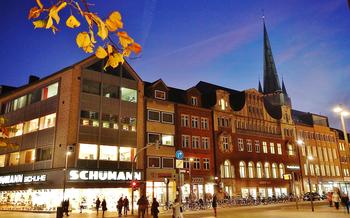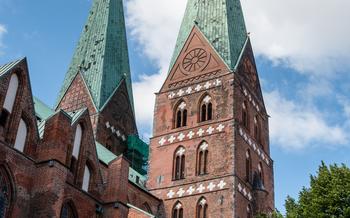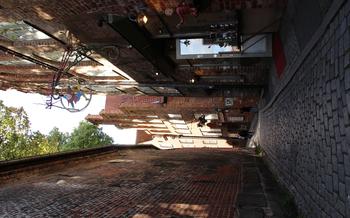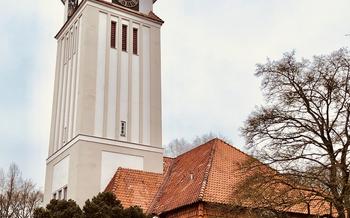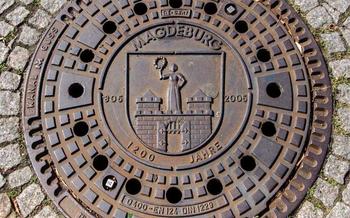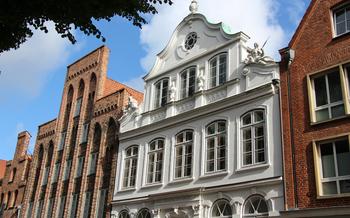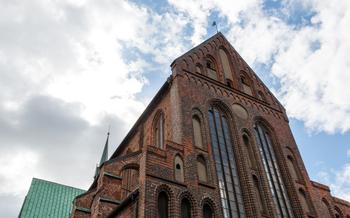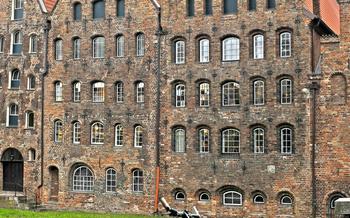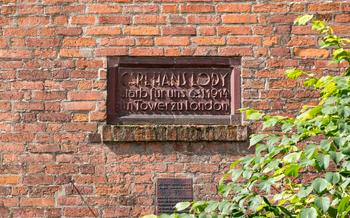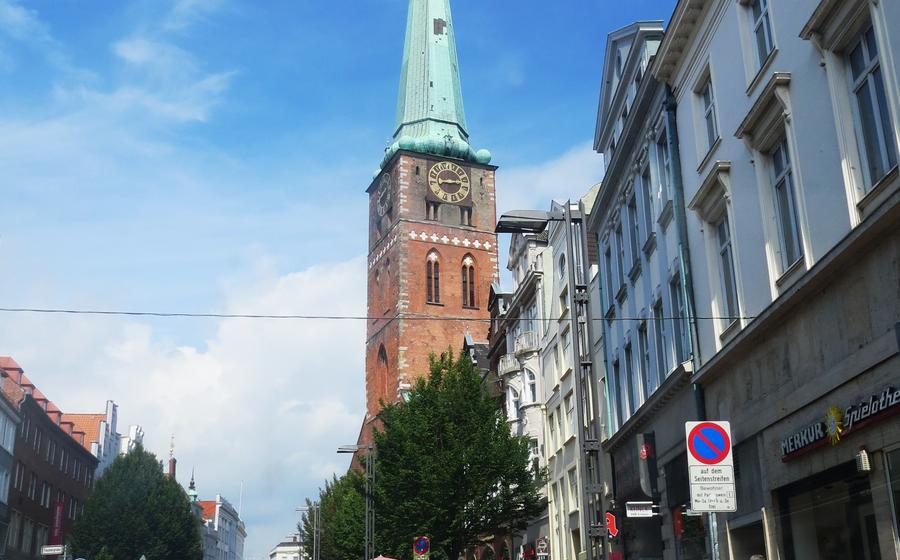
Jakobikirche (St. Jacob's Church)
- History of St. Jacob's Church
- Unique Architectural Features
- Impressive Interior Artwork
- Stunning Stained Glass Windows
- Imposing Bell Tower
- Significant Organ
- Crypt and Catacombs
- Role in the Hanseatic League
- UNESCO World Heritage Site
- Religious Services and Events
- Guided Tours and Accessibility
- Admission Fees and Opening Hours
- Nearby Attractions and Activities
- Insider Tip: A Heavenly Perspective
History of St. Jacob's Church
Built between 1227 and 1335, St. Jacob's Church stands as a testament to the architectural prowess of the 13th and 14th centuries. A masterpiece of Gothic design, the church combines the characteristic pointed arches, ribbed vaults, and flying buttresses of the style. Throughout its history, the church has borne witness to pivotal moments, including the formation of the Hanseatic League and the Protestant Reformation. Its towering presence has served as a spiritual beacon and a symbol of Lübeck's cultural and religious heritage for generations.
Unique Architectural Features
St. Jacob's Church stands out with its magnificent Gothic exterior, characterized by intricate brickwork, pointed arches, and towering spires. The church's grand entrance, adorned with sculptures and reliefs, invites visitors to step into a world of awe-inspiring architecture.
Inside, the church's vaulted ceilings soar overhead, creating a sense of spaciousness and grandeur. The intricate rib vaulting and delicate tracery work showcase the skill and artistry of medieval craftsmen. The church is adorned with an array of stained glass windows, casting a kaleidoscope of colors that illuminate the interior. Each window depicts biblical scenes, historical events, or the lives of saints, adding to the church's rich visual narrative.
One of the most distinctive features of St. Jacob's is its unique nave, which is wider than the chancel, a design rarely seen in Gothic architecture. This unusual feature creates a sense of openness and allows for a more direct connection between the congregation and the altar. The church's massive pillars, adorned with intricate carvings, further enhance the interior's grandeur.
The overall design of St. Jacob's Church reflects the wealth and power of Lübeck during the Hanseatic period. The church's architectural elements, from its intricate carvings to its soaring spires, symbolize the city's status as a major trading center and a hub of religious and cultural activity.
Impressive Interior Artwork
St. Jacob's Church houses a remarkable collection of artwork that adds to its spiritual and aesthetic appeal. Notable among these treasures is the stunning triptych altarpiece, a masterpiece of late Gothic art created by the Lübeck artist Hermen Rode in 1470. Its central panel depicts the crucifixion of Jesus Christ with intricate detail and vivid colors, while the side panels showcase scenes from the life of the Virgin Mary. The altarpiece is not only a testament to Rode's artistic skill but also a profound representation of the church's devotion to the Christian faith.
Another highlight of the church's interior is the series of 16th-century stained glass windows adorning the nave and chancel. These vibrant masterpieces depict scenes from the Old and New Testaments, including the creation of the world, the story of Adam and Eve, and the life of Jesus. The windows' rich colors and intricate designs create a mesmerizing spectacle of light and color, adding to the awe-inspiring atmosphere of the church.
In addition to these major works, St. Jacob's Church is adorned with numerous sculptures, paintings, and decorative elements that contribute to its artistic significance. Visitors can admire the intricately carved choir stalls, the elegant pulpit, and the delicate frescos that grace the walls and ceilings. Each piece of artwork tells a story, reflecting the church's rich history, its dedication to the Christian faith, and its enduring role as a center of artistic and cultural expression.
Stunning Stained Glass Windows
The interior of St. Jacob's Church is further adorned by a series of remarkable stained glass windows, each a masterpiece of craftsmanship and artistry. These windows, dating from the 13th to the 16th centuries, fill the sanctuary with vibrant colors and intricate designs, creating an ethereal atmosphere that inspires awe and contemplation.
The windows depict a variety of biblical and historical scenes, from the life of Christ to the stories of the Old Testament prophets. The vibrant blues, reds, and greens of the glass create a kaleidoscope of light that dances across the church's interior, transforming it into a sacred space of beauty and wonder.
The techniques used to create these stunning windows are as impressive as the designs themselves. The artists employed a combination of traditional stained glass techniques, including cutting, leading, and painting, to achieve the desired effects. The intricate details and lifelike representations of the figures in the windows are a testament to the skill and artistry of the medieval craftsmen who created them.
Beyond their aesthetic value, the stained glass windows of St. Jacob's Church also serve a profound spiritual purpose. They illustrate biblical stories and teachings, providing a visual representation of the church's beliefs and values. The windows invite visitors to reflect on the life of Christ, the history of the church, and the enduring power of faith.
Imposing Bell Tower
Towering over the cityscape, the bell tower of St. Jacob's Church stands as a testament to Lübeck's rich history and architectural prowess. Reaching a height of 125 meters, the tower dominates the skyline, serving as a prominent landmark visible from various points throughout the city. Its distinctive Gothic style is evident in the intricate details and elegant lines that adorn its exterior. The tower's octagonal shape adds to its unique character, setting it apart from other church towers in Lübeck.
Historically, the bell tower has played a crucial role as a navigational aid for seafarers navigating the treacherous waters of the Baltic Sea. Its elevated position offered a clear line of sight, guiding ships safely into the port of Lübeck. The tower's bells, with their distinct tones and melodies, have also played an integral part in the city's daily life, marking the hours, calling the faithful to prayer, and signaling important events.
Visitors to St. Jacob's Church can ascend the tower's 335 steps to reach the viewing platform at the top. The climb is well worth the effort, as it offers breathtaking panoramic views of Lübeck's rooftops, the surrounding countryside, and the distant Baltic Sea. On a clear day, one can even catch a glimpse of the spires of Hamburg's churches in the horizon.
Significant Organ
At the heart of St. Jacob's Church, a remarkable organ stands as a testament to the church's rich musical heritage. Towering over the nave, its imposing presence captivates visitors with its intricate carvings and gilded pipes. Constructed by renowned organ builder Friedrich Stellwagen in the 16th century, this magnificent instrument boasts over 4,000 pipes, each meticulously crafted to produce a harmonious symphony of sound.
Throughout history, the organ has played an integral role in the church's religious ceremonies and community events. Its majestic tones have accompanied countless masses, weddings, and festivals, filling the sacred space with a sense of awe and inspiration. Renowned organists from across Europe have graced St. Jacob's with their performances, enchanting audiences with their virtuosic skills and profound interpretations of classical and sacred music.
Beyond its religious significance, the organ holds a special place in Lübeck's cultural landscape. It has served as a platform for renowned composers to showcase their talents, including the legendary Dietrich Buxtehude, who held the position of organist at St. Jacob's for nearly four decades. His innovative compositions, characterized by their emotional depth and technical brilliance, continue to inspire musicians and music lovers to this day.
To this day, the organ remains a vital part of St. Jacob's vibrant musical tradition. Regular concerts and recitals are held throughout the year, attracting music enthusiasts from far and wide. These performances showcase the organ's versatility, ranging from classical masterpieces to contemporary compositions. Visitors are treated to an immersive musical experience, where the church's acoustics enhance the organ's rich tones, creating a truly unforgettable auditory journey.
Crypt and Catacombs
Beneath the grandeur of St. Jacob's Church lies a hidden realm of mystery and reverence – its crypt and catacombs. These underground chambers offer a glimpse into the church's rich history and the final resting places of notable figures from Lübeck's past.
The crypt, with its dimly lit corridors and vaulted ceilings, houses a collection of tombs and memorials dedicated to prominent citizens, merchants, and clergy who played a significant role in Lübeck's development. Each tomb is adorned with intricate carvings, epitaphs, and coats of arms, narrating the lives and legacies of those interred within.
Descending further, visitors can explore the catacombs, a network of tunnels and chambers that were once used for burials during times of plague or war. The atmosphere here is palpable, with the echoes of history whispering through the ancient walls.
Guided tours of the crypt and catacombs provide a fascinating insight into the lives and deaths of Lübeck's former inhabitants. Visitors can learn about the customs and traditions surrounding death and burial in medieval times, and gain a deeper appreciation for the enduring legacy of St. Jacob's Church.
Role in the Hanseatic League
St. Jacob's Church played a crucial role in the history of the Hanseatic League, a powerful alliance of merchant cities that dominated trade in the Baltic Sea region from the 12th to the 17th century. Lübeck, as one of the leading Hanseatic cities, served as a central meeting place for league members. St. Jacob's Church provided a neutral and sacred space for these gatherings, where merchants, traders, and city representatives came together to discuss trade regulations, resolve disputes, and make important decisions that shaped the economic and political landscape of the Hanseatic League.
The church's impressive size and grand architecture reflected the wealth and power of the Hanseatic League. Its interior was adorned with symbols and artifacts related to trade and commerce, such as ships, scales, and coins. The church also served as a place of worship and spiritual guidance for the merchants and sailors who traveled far and wide, seeking divine protection and guidance on their perilous journeys across the sea.
St. Jacob's Church stands as a testament to the profound influence of the Hanseatic League on the development of Lübeck and the Baltic Sea region. Its role as a gathering place for Hanseatic merchants and the decisions made within its walls shaped the course of history, leaving a lasting legacy that continues to resonate today.
UNESCO World Heritage Site
St. Jacob's Church has achieved the prestigious distinction of being designated as a UNESCO World Heritage Site. This recognition is bestowed upon cultural and natural landmarks of outstanding universal value and significance. The church's inclusion on this prestigious list highlights its exceptional contribution to Lübeck's rich cultural heritage.
UNESCO's stringent criteria for designating World Heritage Sites include factors such as cultural, historical, artistic, and architectural significance. St. Jacob's Church fulfills these criteria remarkably, embodying the architectural prowess of the Gothic era and showcasing exquisite artwork that reflects the religious and cultural traditions of Lübeck.
This prestigious recognition not only underscores the church's importance but also serves as a testament to Lübeck's broader cultural heritage. The city boasts several other UNESCO World Heritage Sites, including the Lübeck Old Town, which together form a tapestry of historical and architectural treasures.
As a UNESCO World Heritage Site, St. Jacob's Church has received international recognition and protection, ensuring its preservation for future generations. This designation has also fueled a renewed interest in the church, attracting visitors from around the globe who seek to witness its architectural splendor and cultural significance.
Religious Services and Events
St. Jacob's Church remains a vibrant center of religious life in Lübeck, offering a diverse range of services and events throughout the year. Regular church services, including masses and prayers, are held on weekdays and Sundays, providing an opportunity for visitors to experience the spiritual atmosphere of the church. The church's liturgical traditions and practices, rooted in centuries of history, are a testament to its enduring role in the community.
Beyond regular services, St. Jacob's also hosts major religious events and festivals that draw worshippers and visitors from across the region. During Christmas and Easter, the church comes alive with festive decorations, special services, and musical performances that celebrate these important holidays. Additionally, the church organizes concerts, lectures, and exhibitions that explore religious themes and promote interfaith dialogue.
Visitors are welcome to participate in religious ceremonies or events held at St. Jacob's. Attending a service or event offers a unique opportunity to immerse oneself in the church's spiritual ambiance and connect with the local community. Whether seeking solace, inspiration, or a deeper understanding of Lübeck's religious heritage, St. Jacob's Church provides a welcoming space for all.
Guided Tours and Accessibility
To fully appreciate the history and beauty of St. Jacob's Church, guided tours are highly recommended. Knowledgeable guides lead visitors through the church, providing insights into its architecture, artwork, and historical significance. Tours are available in multiple languages and cater to various interests, including art history, religious studies, and local history.
For visitors with disabilities, St. Jacob's Church is well-equipped with accessibility features. Ramps and elevators ensure that all areas of the church are accessible, including the crypt and the bell tower. Audio guides are available for visitors who prefer a self-guided experience or require assistance in their preferred language.
When planning your visit, consider the church's opening hours, which vary depending on the season. To avoid crowds, aim to visit during the off-season or on weekdays. For those interested in attending religious services or special events, check the church's website or contact the parish office for more information.
Admission Fees and Opening Hours
Visiting St. Jacob's Church is a budget-friendly experience, with a modest admission fee for adults and discounted rates for students, seniors, and families. Children under six years of age are admitted free of charge. The church welcomes visitors throughout the year, with varying opening hours depending on the season. During the summer months, it remains open from morning until evening, providing ample time for exploration. In the winter, the hours are slightly shorter, but the church still offers visitors a chance to admire its beauty and history. For those seeking a more intimate experience, guided tours are available in multiple languages, offering a deeper insight into the church's significance and stories. Advance booking for tours is recommended, especially during peak tourist season, to avoid disappointment and secure a spot. Whether you choose to explore independently or with a knowledgeable guide, St. Jacob's Church is an accessible and welcoming destination for all.
Nearby Attractions and Activities
St. Jacob's Church is situated in the heart of Lübeck's Old Town, a UNESCO World Heritage Site renowned for its medieval architecture and rich history. After exploring the church, visitors can embark on a journey through the cobblestone streets, discovering hidden courtyards, charming cafés, and unique shops.
Must-see attractions in the vicinity include the majestic Lübeck Cathedral, with its stunning Gothic spires and intricate interior. The Holstentor, a fortified city gate, stands as a symbol of Lübeck's former power and wealth. The Buddenbrookhaus, a former merchant's residence, now serves as a museum dedicated to the renowned Mann family and their literary legacy.
For art enthusiasts, the St. Annen Museum showcases a collection of medieval and modern art, including works by Expressionist painter Emil Nolde. The Günter Grass House, dedicated to the Nobel laureate and Lübeck native, offers insights into his life and literary achievements.
To savor the local flavors, visitors can indulge in traditional German cuisine at one of the many restaurants in the Old Town. From hearty schnitzel to freshly caught seafood, Lübeck's culinary scene caters to every palate.
Lübeck also offers a variety of cultural events throughout the year. The Lübeck Music Festival, held in summer, features performances by renowned musicians from around the world. The Christmas Market, with its festive atmosphere and enchanting decorations, is a magical experience not to be missed.
Whether you seek history, art, food, or festive cheer, Lübeck's Old Town, with St. Jacob's Church at its heart, promises a memorable and enriching experience for every traveler.
Insider Tip: A Heavenly Perspective
For a truly awe-inspiring experience, climb the 206 steps to the top of St. Jacob's bell tower. The panoramic views from the observation deck are simply breathtaking. Gaze out over the red-tiled rooftops of Lübeck's Old Town, the spires of neighboring churches, and the shimmering waters of the Baltic Sea in the distance. On a clear day, you can even spot the spires of Hamburg Cathedral, some 60 kilometers away. This unique perspective offers a new appreciation for the grandeur of St. Jacob's and its role as a beacon of faith and history in this beautiful Hanseatic city.
